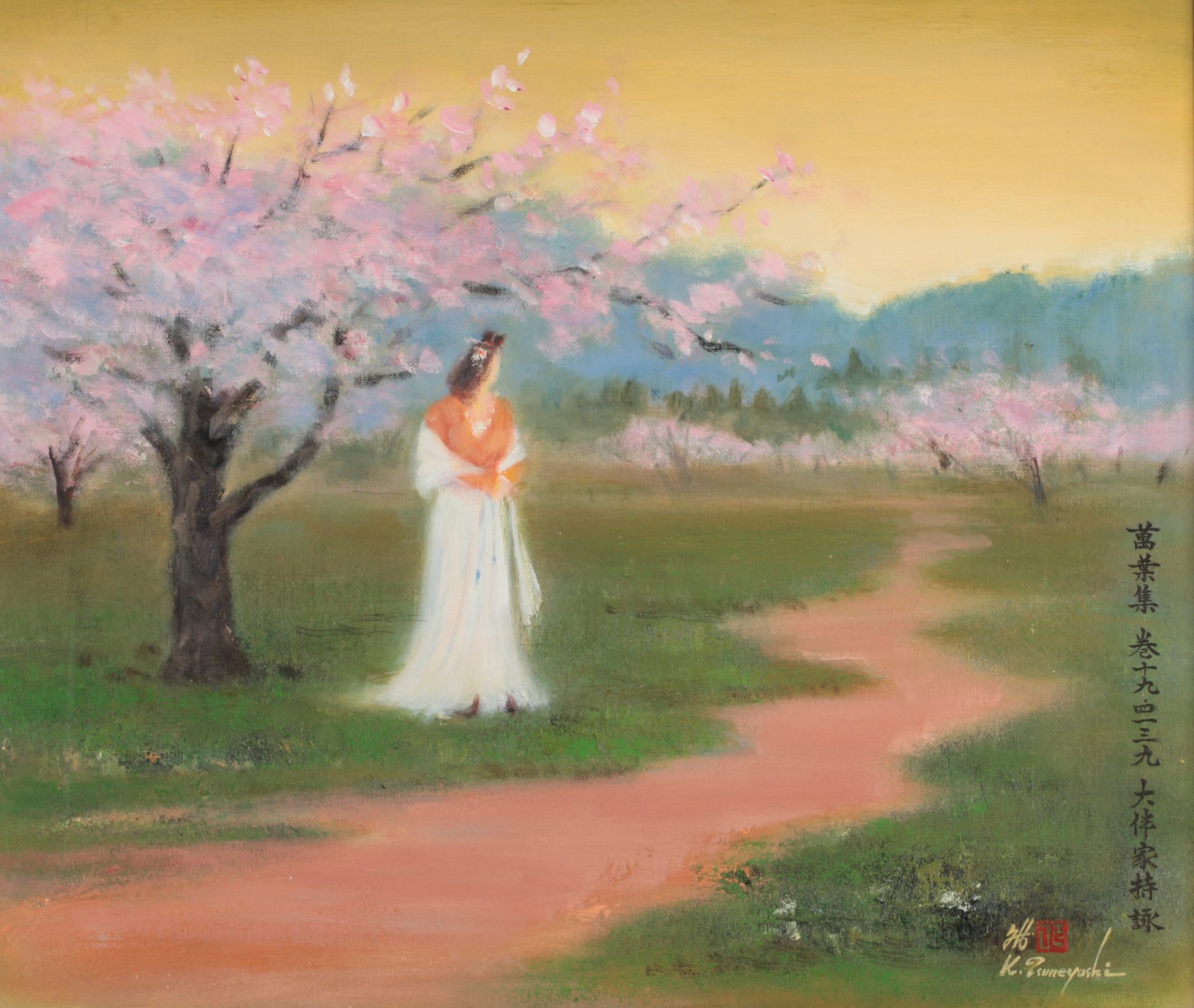歌碑15「春の苑」-光暁寺 前庭Monument No.15“ Springtime Garden”-Front Garden of Kōgyōji Temple
2022年09月01日

桃と少女の取り合わせは漢詩に見られる趣向。そのため、一首全体に中国風の華やかな雰囲気が漂う。越中(富山県)に赴任していた家持はこの時期、美に対する繊細な感受性に裏打ちされた漢詩的・絵画的な歌をいくつも詠んだ。(日下常由「春の苑」高岡市万葉歴史館蔵)
The juxtaposition of a peach and a girl appears frequently in Chinese poetry, and this entire poem presents a richly textured Chinese-style atmosphere. During his assignment in Etchū (Toyama Prefecture), Yakamochi composed a series of picturesque poems that, while reminiscent of Chinese poetry, are yet rooted in his own delicate sense of beauty. (“Springtime Garden” Teneyoshi KUSAKA Collection of Takaoka Manyo Historical Museum)
![万葉歌めぐりの旅[Man'yōshū Literary Pilgrimage]](https://www.manreki.com/manyo-songs/images/common/pic_logo.svg)















解説
Commentary
春の苑
Springtime Garden
『万葉集』の4139番の歌。『万葉集』は、7世紀前半から8世紀後半にかけての約130年間の歌を収めた現存日本最古の歌集で、4500首余りの歌が収められている。この歌の作者は大伴家持(718?~785)、『万葉集』でも最も多くの歌を残す歌人である。
全二十巻で構成される『万葉集』の中で、この歌は巻十九の巻頭を飾る歌。巻十九の巻頭には桃と李の花を詠む二首が並び、これはそのうち桃花を詠んだ一首目。
この歌の理解の仕方には議論がある。初句と三句で切れると見れば、「春の苑」「桃の花」「娘子」という三つのものを並べた歌と捉えることができる。それに対して、二句で切れると見れば、桃花と乙女とが照応して庭園全体が紅色に輝く歌となる。今回は後者の説で解釈した。
桃と少女の取り合わせは漢詩に見られる趣向。そのため、一首全体に中国風の華やかな雰囲気が漂う。越中(富山県)に赴任していた家持はこの時期、美に対する繊細な感受性に裏打ちされた漢詩的・絵画的な歌をいくつも詠んだ。特にこの歌に始まる三月一日~三日朝にかけての十二首は「越中秀吟」と呼ばれ、高く評価されている。
この歌には、「春の苑」「紅にほふ」「桃の花」「道」「娘子」と、全ての句に詩的な要素が含まれており、幻想的な風景が思い浮かぶだろう。ロマンと美しさに満ちた甘美な物語を呼び起こすような、驚くほどの繊細さを備えた歌である。
高岡市の伏木小学校校庭や光曉寺前庭に歌碑が立つ。
(解説 ピーター・J・マクミラン)
This is poem number 4139 of the Man’yōshū, the oldest existing collection of poetry in Japan. The Man’yōshū consists of over 4,500 poems and was compiled over a period of around 130 years, from the first part of the 7th century to the latter part of the 8th century. The author of this poem is Ōtomo no Yakamochi.
There are a pair of two poems at the beginning of Book 19. This is the first poem and it depicts peach blossoms, while the second depicts the sumomo plum blossoms. There is some debate as to how to interpret the meaning of the poem. If the original is divided into three parts, it can be interpreted as a poem with three motifs: “a spring garden,” “peach flowers,” and “a maiden.” If it is divided into two parts, it celebrates the garden that is illuminated by the blossoms that also illuminate the maiden. The present translation follows the latter interpretation.
The juxtaposition of a peach and a girl appears frequently in Chinese poetry, and this entire poem presents a richly textured Chinese-style atmosphere. During his assignment in Etchū (Toyama Prefecture), Yakamochi composed a series of picturesque poems that, while reminiscent of Chinese poetry, are yet rooted in his own delicate sense of beauty. The twelve poems, of which this is the first, were composed between the 1st day of the third month and the morning of the 3rd day of the third month. These poems are known as “Etchū Shūgin” (Splendid Poems of Etchū) and are some of the most highly regarded poems from Yakamochi’s time in Etchū.
Every line in this poem contains poetic elements: The “springtime garden,” “glows in reds,” “a path,” “peach blossoms,” and a “maiden.” Together they create a work of remarkable delicacy that invokes a narrative filled with romance and beauty.
These waka poem stone monuments stand in the schoolyard of Fushiki Elementary School and in the front garden of Kokyoji Temple in Takaoka City.
(English Translation and Commentary by Peter Macmillan)